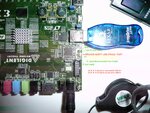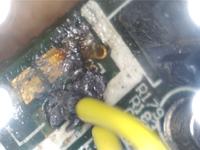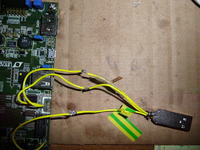Elektronman
Member level 5

Hello,
I've decided to post a picture of the accident which occurred some days ago: I have already talked about it in the thread:
https://www.edaboard.com/threads/226859/
Basically, I bought this Atlys board, and while trying to put it in a small plastic case, I accidentaly teared off the USB ADEPT port used to configure the FPGA...
the USB ADEPT port used to configure the FPGA...
while trying to repair it myself... I ended up messing even more the USB port.
I have attached the picture, where you can easily see the damaged port...
The worst problem is that the USB D- signal pad is disconnected from the track.. and I have no idea how to reconnect those part by soldering... I lack any precision tool able to do something like that.. I tried with my soldering iron but the tip was too wide...
The D+ pad also has a via on the other side of the PCB that connect with the track that goes into the Cypress MCU at pin 8 (D_P), in the picture you don't see this via and you have a misperception of D+ and D- swapped.. but that's not true, it is just an optical illusion...
Unfortunately I have no warranty for this board...
Does anyone know how should I repair myself this port, and if it is doable? My idea was that of soldering some wires to the pads.. and then trying to reconnect the signals to a USB port (even a different larger USB port...), and what about signal integrity.. if I mess up with USB signals (adding wires or pads or whathever...) isn't the risk of compromising signals integrity with parassite capacitances and stuff like that... and having problems with high frequencies USB signals?
Thank you very much
Here is the picture of the damaged Atlys board:

I've decided to post a picture of the accident which occurred some days ago: I have already talked about it in the thread:
https://www.edaboard.com/threads/226859/
Basically, I bought this Atlys board, and while trying to put it in a small plastic case, I accidentaly teared off
while trying to repair it myself... I ended up messing even more the USB port.
I have attached the picture, where you can easily see the damaged port...
The worst problem is that the USB D- signal pad is disconnected from the track.. and I have no idea how to reconnect those part by soldering... I lack any precision tool able to do something like that.. I tried with my soldering iron but the tip was too wide...
The D+ pad also has a via on the other side of the PCB that connect with the track that goes into the Cypress MCU at pin 8 (D_P), in the picture you don't see this via and you have a misperception of D+ and D- swapped.. but that's not true, it is just an optical illusion...
Unfortunately I have no warranty for this board...
Does anyone know how should I repair myself this port, and if it is doable? My idea was that of soldering some wires to the pads.. and then trying to reconnect the signals to a USB port (even a different larger USB port...), and what about signal integrity.. if I mess up with USB signals (adding wires or pads or whathever...) isn't the risk of compromising signals integrity with parassite capacitances and stuff like that... and having problems with high frequencies USB signals?
Thank you very much
Here is the picture of the damaged Atlys board:





